Lectrosonics SMWB Handleiding
Lectrosonics
Microfoon
SMWB
Bekijk gratis de handleiding van Lectrosonics SMWB (30 pagina’s), behorend tot de categorie Microfoon. Deze gids werd als nuttig beoordeeld door 32 mensen en kreeg gemiddeld 4.8 sterren uit 16.5 reviews. Heb je een vraag over Lectrosonics SMWB of wil je andere gebruikers van dit product iets vragen? Stel een vraag
Pagina 1/30

SMWB Series
Wireless Microphone Transmitters and Recorders
SMWB, SMDWB, SMWB/E01, SMDWB/E01, SMWB/X, SMDWB/X
Featuring
Digital Hybrid Wireless® Technology
US Patent 7,225,135
INSTRUCTION MANUAL
Rio Rancho, NM, USA
www.lectrosonics.com
Fill in for your records:
Serial Number:
Purchase Date:
SMWB SMDWB

SMWB Series
LECTROSONICS, INC.
2
Introduction
The design of the SMWB transmitter delivers the ad-
vanced technology and features of Digital Hybrid Wire-
less® in a Lectrosonics belt-pack transmitter at a modest
cost. Digital Hybrid Wireless® combines a 24-bit digital
audio chain with an analog FM radio link to eliminate a
compandor and its artifacts, yet preserve the extended
operating range and noise rejection of the finest analog
wireless systems.
The housing is a rugged, machined aluminum pack-
age with a standard Lectrosonics 5-pin input jack for
use with electret lavaliere mics, dynamic mics, musical
instrument pickups and line level signals. The LEDs
on the keypad allow quick and accurate level settings
without having to view the receiver. The unit is powered
by AA batteries, one battery in the SMWB and two in
the SMDWB. The antenna port uses a standard 50 ohm
SMA connector.
Switching power supplies provide constant voltages to
the transmitter circuits from the beginning to the end of
battery life, with output power remaining constant over
the life of the battery. The input amplifier uses an ultra
low noise op amp. Input gain is adjustable over a 44 dB
range, with a DSP-controlled dual envelope input limiter
providing a clean 30 dB range to prevent overload from
signal peaks.
About Digital Hybrid Wireless®
All wireless links suffer from channel noise to some
degree, and all wireless microphone systems seek to
minimize the impact of that noise on the desired signal.
Conventional analog systems use compandors for
enhanced dynamic range, at the cost of subtle artifacts
(known as “pumping” and “breathing”). Wholly digital
systems defeat the noise by sending the audio informa-
tion in digital form, at the cost of some combination of
power, bandwidth, operating range and resistance to
interference.
The Lectrosonics Digital Hybrid Wireless system over-
comes channel noise in a dramatically new way, digitally
encoding the audio in the transmitter and decoding it
in the receiver, yet still sending the encoded informa-
tion via an analog FM wireless link. This proprietary
algorithm is not a digital implementation of an analog
compandor but a technique which can be accomplished
only in the digital domain.
Since the RF link between transmitter and receiver is
FM, channel noise will increase gradually with in-
creased operating range and weak signal conditions,
however, the Digital Hybrid Wireles system handles this
situation elegantly with rarely audible audio artifacts as
the receiver approaches its squelch threshold.
In contrast, a purely digital system tends to drop the
audio suddenly during brief dropouts and weak signal
conditions. The Digital Hybrid Wireless system simply
encodes the signal to use a noisy channel as efficiently
Table of Contents
Introduction 2 ............................................................................
About Digital Hybrid Wireless® 2 ...............................................................................
Servo Bias Input and Wiring 3 ................................................
DSP-controlled Input Limiter 3 ................................................
Recorder function 3 .................................................................
Compatibility withmicroSDHC memory cards 3 ....................
Features 4 ..................................................................................
Battery Status LED Indicator 4 ...............................................
Menu Shortcuts 4 ....................................................................
IR (infrared) Sync 4 .................................................................
Battery Installation 5 ...............................................................
Formatting SD Card 5 ...............................................................
IMPORTANT 5 ..........................................................................
iXML HEADER SUPPORT 5 ..................................................
Turning Power ON 6 .................................................................
Short Button Press 6 ...............................................................
Long Button Press 6 ...............................................................
Menu Shortcuts 6 ....................................................................
Transmitter Operating Instructions 7 .....................................
Recorder Operating Instructions 7 .........................................
SMWB Main Menu 8 ..................................................................
SMWB Power Button Menu 9 ...................................................
Setup Screen Details 10 ............................................................
Locking/Unlocking Changes to Settings............................... 10
Main Window Indicators ....................................................... 10
Connecting the Signal Source 10 .............................................
Turning Control Panel LEDs ON/OFF 10 ..................................
Helpful Features on Receivers 10 .............................................
Files 10 .....................................................................................
Record or Stop 11 ....................................................................
Adjusting the Input Gain 11 .......................................................
Selecting Frequency 11 ............................................................
Selecting Frequency Using Two Buttons 12 ..............................
About Overlapping Frequency Bands 12 ..................................
Selecting the Low Frequency Roll-off 12 ..................................
Selecting the Compatibility (Compat) Mode 12 .........................
Selecting Step Size 13 ..............................................................
Selecting Audio Polarity (Phase) 13 ..........................................
Setting Transmitter Output Power 13 ........................................
Setting Scene and Take Number 13 .........................................
Choosing Takes for Replay 13 ..................................................
Recorded File Naming 13 ........................................................
SD Info 13 .................................................................................
Restoring Default Settings 13 ...................................................
5-Pin Input Jack Wiring 14 .........................................................
Microphone Cable Termination
for Non-Lectrosonics Microphones 15 ..............................
Input Jack Wiring for Different Sources 16 ..............................
Microphone RF Bypassing 17 ...................................................
Line Level Signals 17 ................................................................
Firmware Update 18 ...................................................................
Recovery Process 19 .................................................................
Declaration of Conformity..................................................... 19
Silver Paste on SM Series Transmitter Thumbscrews 20 ........
Straight Whip Antennas ........................................................ 21
Belt Clips and Pouches 22 .........................................................
SMWB Single Battery Model 22 ...............................................
SMDWB Dual Battery Model 22 ................................................
Miscellaneous Accessories 23 ..................................................
LectroRM 24 ................................................................................
Specifications 25 ........................................................................
Troubleshooting 26 .....................................................................
Service and Repair 28 ................................................................
Returning Units for Repair 28 ...................................................

Digital Hybrid Wireless Belt-Pack Transmitters
Rio Rancho, NM 3
and robustly as possible, yielding audio performance
that rivals that of purely digital systems, without the
power, noise and bandwidth problems inherent in digital
transmission. Because it uses an analog FM link, Digital
Hybrid Wireless enjoys all the benefits of conventional
FM wireless systems, such as excellent range, efficient
use of RF spectrum, and long battery life.
Servo Bias Input and Wiring
The input preamp is a unique design that delivers
audible improvements over conventional transmitter
inputs. Two different microphone wiring schemes are
available to simplify and standardize the configuration.
Simplified 2-wire and 3-wire configurations provide sev-
eral arrangements designed for use only with servo bias
inputs to take full advantage of the preamp circuitry.
A line level input wiring provides an extended frequency
response with an LF roll-off at 35 Hz for use with instru-
ments and line level signal sources.
DSP-controlled Input Limiter
The transmitter employs a digitally-controlled analog
audio limiter prior to the analog-to-digital converter.
The limiter has a range greater than 30 dB for excellent
overload protection. A dual release envelope makes the
limiter acoustically transparent while maintaining low
distortion. It can be thought of as two limiters in series,
connected as a fast attack and release limiter followed
by a slow attack and release limiter. The limiter recovers
quickly from brief transients, so that its action is hidden
from the listener, but recovers slowly from sustained
high levels to keep audio distortion low and preserve
short term dynamic changes in the audio.
Recorder function
The SMWB has a built in recording function for use in
situations where RF may not be possible or to work as
a stand alone recorder. The record function and trans-
mit functions are exclusive of each other - you cannot
record AND transmit at the same time. When the unit is
transmitting and recording is turned on, the audio in the
RF transmission will stop, but the battery status will still
be sent to the receiver.
The recorder samples at 44.1kHz rate with a 24 bit
sample depth. (the rate was selected due to the re-
quired 44.1kHz rate used for the digital hybrid algo-
rithm). The micro SDHC card also offers easy firmware
update capabilities without the need for a USB cable or
driver issues.
Compatibility with
microSDHC memory cards
Please note that the SMWB and SMDWB are designed
for use with microSDHC memory cards. There are
several types of SD card standards (as of this writing)
based on capacity (storage in GB).
SDSC: standard capacity, up to and including 2 GB –
DO NOT USE!
SDHC: high capacity, more than 2 GB and up to and
including 32 GB – .USE THIS TYPE
SDXC: extended capacity, more than 32 GB and up to
and including 2 TB – DO NOT USE!
SDUC: extended capacity, more than 2TB and up to
and including 128 TB – DO NOT USE!
The larger XC and UC cards use a different formatting
method and bus structure and are NOT compatible with
the recorder. These are typically used with later genera-
tion video systems and cameras for image applications
(video and high resolution, high speed photography).
ONLY microSDHC memory cards should be used. They
are available in capacities from 4GB to 32GB. Look for
the Speed Class 10 cards (as indicated by a C wrapped
around the number 10), or the UHS Speed Class I
cards (as indicated by the numeral 1 inside a U sym-
bol). Also note the Logo.microSDHC
If you are switching to a new brand or source of card,
we always suggest testing first before using the card on
a critical application.
The following markings will appear on compatible
memory cards. One or all of the markings will appear on
the card housing and the packaging.
UHS Speed Class I Stand-alone
Speed Class 10
UHS Speed Class 1
UHS Speed Class I
Accompanying
microSDHC logo
microSDHC Logo is a trademark of SD-3C, LLC
Product specificaties
| Merk: | Lectrosonics |
| Categorie: | Microfoon |
| Model: | SMWB |
Heb je hulp nodig?
Als je hulp nodig hebt met Lectrosonics SMWB stel dan hieronder een vraag en andere gebruikers zullen je antwoorden
Handleiding Microfoon Lectrosonics

28 Januari 2025

16 November 2023

16 November 2023

16 November 2023

16 November 2023

16 November 2023

15 November 2023

15 November 2023

15 November 2023

15 November 2023
Handleiding Microfoon
- Intricon
- CMTECK
- SE Electronics
- Wedaniya
- Majority
- Sennheiser
- Apart
- ART
- Konig & Meyer
- HiRO
- Pyle
- T'nB
- Speed-Link
- CKMOVA
- Relacart
Nieuwste handleidingen voor Microfoon
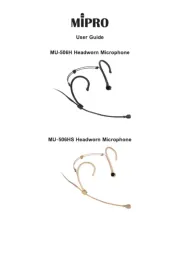
29 Juli 2025
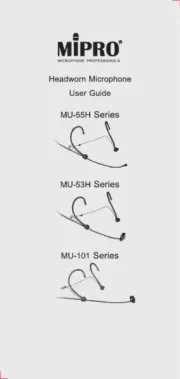
29 Juli 2025
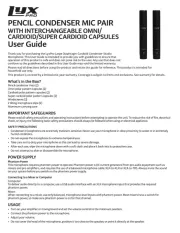
29 Juli 2025

29 Juli 2025
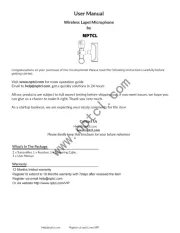
28 Juli 2025
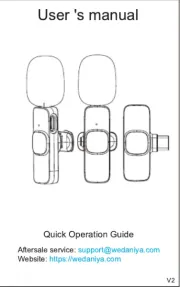
28 Juli 2025
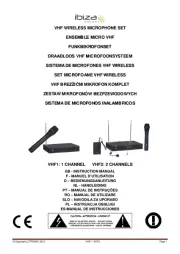
28 Juli 2025
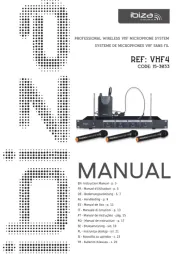
28 Juli 2025
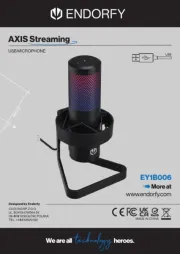
23 Juli 2025
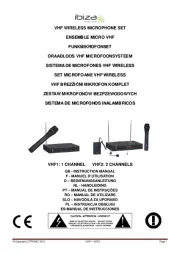
22 Juli 2025